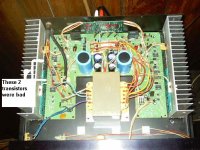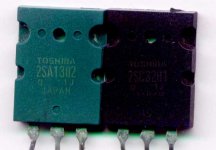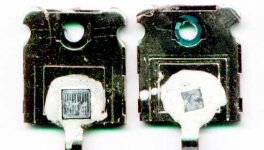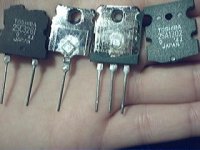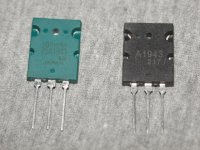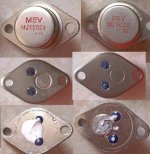OK I think the one on the right is a Fake.
Good one readings for EB:
With black probe on E: 4.37 nF
With red probe on E: 11.37 nF
Fake one readings:
With black probe on E: 1.66 nF
With red probe on E: 2.05 nF
Me also thinks that putting the red probe on the E (for an NPN device) simulates the readings for EB that you got... kind of.
i.e. the one on the right with large font seems to be fake, Also look at the mounting hole, it is smaller for the fake one. What do you think Eva?
😉
Good one readings for EB:
With black probe on E: 4.37 nF
With red probe on E: 11.37 nF
Fake one readings:
With black probe on E: 1.66 nF
With red probe on E: 2.05 nF
Me also thinks that putting the red probe on the E (for an NPN device) simulates the readings for EB that you got... kind of.
i.e. the one on the right with large font seems to be fake, Also look at the mounting hole, it is smaller for the fake one. What do you think Eva?
😉
With these values I'm sure the second device is a fake
The first device is probably genuine but I can't guarantee it. We would need to measure a device of the same model known to be genuine to find out its typical capacitances
Maybe somebody reading this has some genuine 2SC5359, a capacitance meter and some patience to measure them 🙂
In the other hand, your meter is forward/reverse biasing the junctions depending of the polarity you use to measure. This explains this huge difference [4 vs 11nF] since reverse biasing a juction reduces its capacitance and forward biasing it increases capacitance and starts conduction when 0.5V are reached. The real zero-bias capacitance value will be between these two values you have obtained, maybe 8nF. [With my meter, I get the same measurement independently of polarity]
The first device is probably genuine but I can't guarantee it. We would need to measure a device of the same model known to be genuine to find out its typical capacitances
Maybe somebody reading this has some genuine 2SC5359, a capacitance meter and some patience to measure them 🙂
In the other hand, your meter is forward/reverse biasing the junctions depending of the polarity you use to measure. This explains this huge difference [4 vs 11nF] since reverse biasing a juction reduces its capacitance and forward biasing it increases capacitance and starts conduction when 0.5V are reached. The real zero-bias capacitance value will be between these two values you have obtained, maybe 8nF. [With my meter, I get the same measurement independently of polarity]
Eva, you're simply amazing😎 I took you up on your offer, I happened to be lucky enough to have a fake and an original 2SA1302 laying around and I did measure the capacitance, per your post.
The original 2SA1302 measures
1.36nF from collector to emitter and;
1.77nF from collector to base.
The fake measures;
0.43nF from collector to emitter and;
0.52nF from collector to base.
I don't know how accurate my DMM is but nonetheless, there's a wide difference here. HMMMMMM
It's not a critical reference for measuring transistors, but it sounds like it will get you in the ballpark.
I do have the fake available for any of you that would like to test it (blow it up, put it out of it's misery) and post the results, then it!😉 . Oh, please post photos. I can have it shipped to you at no cost.
it!😉 . Oh, please post photos. I can have it shipped to you at no cost.
Thanks Eva for your information, that'll at least get us in whether we have bad transistors or not!🙂 🙂 🙂
The original 2SA1302 measures
1.36nF from collector to emitter and;
1.77nF from collector to base.
The fake measures;
0.43nF from collector to emitter and;
0.52nF from collector to base.
I don't know how accurate my DMM is but nonetheless, there's a wide difference here. HMMMMMM

It's not a critical reference for measuring transistors, but it sounds like it will get you in the ballpark.
I do have the fake available for any of you that would like to test it (blow it up, put it out of it's misery) and post the results, then
 it!😉 . Oh, please post photos. I can have it shipped to you at no cost.
it!😉 . Oh, please post photos. I can have it shipped to you at no cost.Thanks Eva for your information, that'll at least get us in whether we have bad transistors or not!🙂 🙂 🙂
Do you like fake 2SC3281 and 2SA1302?
There are thousands of different fake variants since production of the original devices by toshiba stopped 5 years ago or so ...
All the 2SC3281 and 2SA1302 sold today are fakes. Yours are also both fakes...
Look at these of my fake 2SC3281 and 2SA1302 collection...
😀😀😀
The PNP uses the die of something like a 40W TO-220 and the NPN may be a 75W TO-220. The original devices are rated at 150W so try to figure out the size of the die used on the genuine devices
There are thousands of different fake variants since production of the original devices by toshiba stopped 5 years ago or so ...
All the 2SC3281 and 2SA1302 sold today are fakes. Yours are also both fakes...
Look at these of my fake 2SC3281 and 2SA1302 collection...
😀😀😀
The PNP uses the die of something like a 40W TO-220 and the NPN may be a 75W TO-220. The original devices are rated at 150W so try to figure out the size of the die used on the genuine devices
Attachments
RimBand,
I live in Indy, if you can ship the fakes to me, I will measure and post the results,
-K
I live in Indy, if you can ship the fakes to me, I will measure and post the results,
-K
Alot has been said about the power handling of the fakes but how does the Hfe roll off compare.
One reason for using these devices is that the Hfe remains high even with high current drain as compared to other similar power related devices.
One reason for using these devices is that the Hfe remains high even with high current drain as compared to other similar power related devices.
True, in my case Vce and Hfe were the primary reasons for choosing these devices not power handling...
-K
-K
The dies used in fake devices have nothing to do with the original dies. Fake dies have different design and properties. Current gain starts to roll of at a much lower Ic [like in old bipolars] and FT is lower [also like in old bipolars]
I started to suspect these devices were fakes when I noticed unexpected RF oscillations for Ic>2.5A [in a circuit stable with genuine devices] trhat appeard to be caused by a too low FT that also starts to roll off at low Ic levels
I started to suspect these devices were fakes when I noticed unexpected RF oscillations for Ic>2.5A [in a circuit stable with genuine devices] trhat appeard to be caused by a too low FT that also starts to roll off at low Ic levels
This device looks more like a no-brand clone than to a fake. It may be not as bad as fakes
Could you measure C-B and E-B capacitances of both devices?
Masuring some Hfe and Vbe data would also be useful for comparing
Opening the case of a genuine and a clone to see what's inside would also be useful, but I'm aware that transistors cost money 🙂
Could you measure C-B and E-B capacitances of both devices?
Masuring some Hfe and Vbe data would also be useful for comparing
Opening the case of a genuine and a clone to see what's inside would also be useful, but I'm aware that transistors cost money 🙂
K-amps, sorry I didn't get back you last week about me sending the fake 2SA1302 for testing. You can contact me at rimband@hotmail.com (not my main E-mail address), and I'll give you my DSL address. We can then make arrangements for me to ship you the 2SA1302.
Nothing against you or DiyAudio.com, but posting my main address is off limits, you know kow the Spam-Bots harvest E-mails from web pages. I don't want a lot of spam in my main account.
Take care K-amps, hope to hear from ya soon!🙂
P.S.>I'll ship it out to you no charge as promised, plus I'll include a datasheet for the 2SA1302.
Nothing against you or DiyAudio.com, but posting my main address is off limits, you know kow the Spam-Bots harvest E-mails from web pages. I don't want a lot of spam in my main account.

Take care K-amps, hope to hear from ya soon!🙂
P.S.>I'll ship it out to you no charge as promised, plus I'll include a datasheet for the 2SA1302.
I am just curious as to how the economics work for counterfeit transistors.
for ICs, the wafer is very inexpensive. it is no uncommon that packaging costs 90% of the total costs for a small IC. the "counterfeits" look just as well packaged and even if there is no die in the package, they need to incur 90% of the cost of a real thing.
maybe the profit margins on the real thing are very high.
for ICs, the wafer is very inexpensive. it is no uncommon that packaging costs 90% of the total costs for a small IC. the "counterfeits" look just as well packaged and even if there is no die in the package, they need to incur 90% of the cost of a real thing.
maybe the profit margins on the real thing are very high.
The standard cost of a given part is lesser than it's selling price. So as far as the fake manufacturer can attain a positive contribution margin per unit, He is happy selling whatever he can.
Also some production lines need to have higher capacity utilization to meet their basic overheads i.e. Rent/ Utilities. That need to be met or they shut down.
By selling fakes, they have more or less confirmed sales because Toshiba is paying for all their advertising. 😡
Also some production lines need to have higher capacity utilization to meet their basic overheads i.e. Rent/ Utilities. That need to be met or they shut down.
By selling fakes, they have more or less confirmed sales because Toshiba is paying for all their advertising. 😡
Millwood wrote; I am just curious as to how the economics work for counterfeit transistors.
for ICs, the wafer is very inexpensive. it is no uncommon that packaging costs 90% of the total costs for a small IC. the "counterfeits" look just as well packaged and even if there is no die in the package, they need to incur 90% of the cost of a real thing.
maybe the profit margins on the real thing are very high.
Millwood, that reminds me of a few years ago, a friend of mine and I got into a discussion about computer mainboards and the L2 cache on the boards.
I read an article on the Internet then about some Chinese made mainboards with Intel Chipsets, (I don't remember it fully), but they were putting bogus L2 cache chips on these mainboards.
When you look at the mainboard, the L2 chips looked legit, with part numbers and all, but there was no dies within the chips.😕 That's right, it was a blank epoxy case, complete with pins, but no active piece of silicon inside.
That's right, it was a blank epoxy case, complete with pins, but no active piece of silicon inside.
I'm not sure who made the mainboards, but that same friend and I upgraded his mainboard to 96MB of RAM and it freaked out. It locked up at will. The memory wasn't bad, we tested it and it was good, the machine at end wouldn't take more than 64MB of RAM before it became flaky. It makes you wonder.
Sorry about being off topic about my friend's computer, but your post raised my eyebrows. You and others may want to search around the Internet to find that article, it's been a few years ago, if I could remember the link, I would happily post it.
Take care and be good!🙂
for ICs, the wafer is very inexpensive. it is no uncommon that packaging costs 90% of the total costs for a small IC. the "counterfeits" look just as well packaged and even if there is no die in the package, they need to incur 90% of the cost of a real thing.
maybe the profit margins on the real thing are very high.
Millwood, that reminds me of a few years ago, a friend of mine and I got into a discussion about computer mainboards and the L2 cache on the boards.
I read an article on the Internet then about some Chinese made mainboards with Intel Chipsets, (I don't remember it fully), but they were putting bogus L2 cache chips on these mainboards.
When you look at the mainboard, the L2 chips looked legit, with part numbers and all, but there was no dies within the chips.😕
 That's right, it was a blank epoxy case, complete with pins, but no active piece of silicon inside.
That's right, it was a blank epoxy case, complete with pins, but no active piece of silicon inside.I'm not sure who made the mainboards, but that same friend and I upgraded his mainboard to 96MB of RAM and it freaked out. It locked up at will. The memory wasn't bad, we tested it and it was good, the machine at end wouldn't take more than 64MB of RAM before it became flaky. It makes you wonder.
Sorry about being off topic about my friend's computer, but your post raised my eyebrows. You and others may want to search around the Internet to find that article, it's been a few years ago, if I could remember the link, I would happily post it.
Take care and be good!🙂
More MEV transistors!
I was unlucky enough to have purchased a bunch of MJ15024/MJ15025 transistors with the MEV markings. As soon as any significant power was applied to them they failed, taking out drivers as well.😡
As soon as I started using genuine ON Semi parts the problems ceased.
Here are pics of the MEV parts:
I was unlucky enough to have purchased a bunch of MJ15024/MJ15025 transistors with the MEV markings. As soon as any significant power was applied to them they failed, taking out drivers as well.😡
As soon as I started using genuine ON Semi parts the problems ceased.
Here are pics of the MEV parts:
Attachments
- Status
- Not open for further replies.
- Home
- Amplifiers
- Solid State
- counterfiet sa1943's ??
